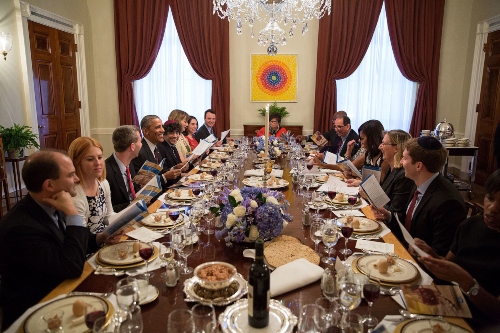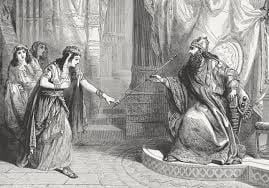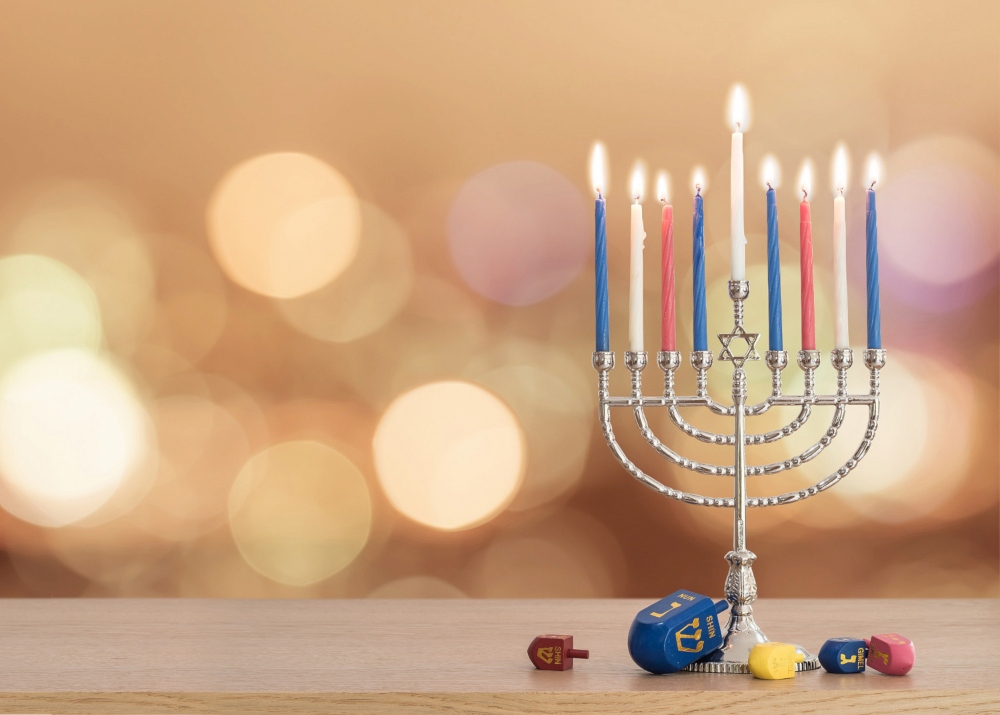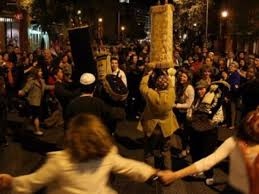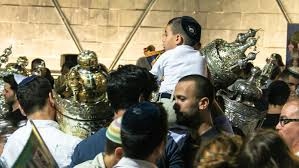The fast of the 17th of the Hebrew month of Tammuz, known as Shivah Asar B’Tammuz, is the start of a three-week mourning period for the destruction of Jerusalem and the two Holy Temples.
Archives: Directory listings
Directory listings
Shavuot
Shavuot, the feast of weeks, is celebrated seven weeks after the second Passover seder. Although Shavuot began as an ancient grain harvest festival, the holiday has been identified since biblical times with the giving of the Torah on Mount Sinai.
The word Shavuot means “weeks”, and it marks the conclusion of the Counting of the Omer. Its date is directly linked to that of Passover; the Torah mandates the seven-week Counting of the Omer, beginning on the second day of Passover, to be immediately followed by Shavuot. This counting of days and weeks is understood to express anticipation and desire for the giving of the Torah. On Passover, the people of Israel were freed from their enslavement to Pharaoh; on Shavuot, they were given the Torah and became a nation committed to serving God.
One of the biblically ordained Three Pilgrimage Festivals, Shavuot is traditionally celebrated in the Land of Israel for one day and for two days in the Diaspora. While there is more awareness of the festival in Israel among secular Jews, generally Shavuot is widely ignored by non-practicing Jews.
The practice of staying up all Shavuot night to study Torah – known as Tiqun Leyl Shavuot – is linked to a Midrash which relates that the night before the Torah was given, the Israelites retired early to be well-rested for the momentous day ahead. They overslept and Moses had to wake them up because God was already waiting on the mountaintop. To rectify this perceived flaw in the national character, many religious Jews stay up all night to learn Torah.
Any subject may be studied on Shavuot night, although Talmud, Mishnah, and Torah typically top the list. People may learn alone or with a chavruta (study partner), or attend late-night shiurim (lectures) and study groups. In keeping with the custom of engaging in all-night Torah study, leading 16th century kabbalist Isaac Luria arranged a recital consisting of excerpts from the beginning and end of each of the 24 books of Tanakh (including the reading in full of several key sections such as the account of the days of creation, the Exodus, the giving of the Ten Commandments and the Shema) and the 63 tractates of Mishnah, followed by the reading of Sefer Yetzirah, the 613 commandments as enumerated by Maimonides, and excerpts from the Zohar, with opening and concluding prayers. The whole reading is divided into thirteen parts, after each of which a Kaddish d-Rabbanan is recited when the Tiqun is studied with a minyan. Today, this service is held in many communities, with the notable exception of Spanish and Portuguese Jews. The service is printed in a book called Tiqun Leyl Shavuot. There exist similar books for the vigils before the seventh day of Pesach and Hosha’ana Rabbah.
Pesach
Pesach (Passover) is a festival of freedom. It commemorates the Israelites’ Exodus from Egypt, and their transition from slavery to freedom. The main ritual of Pesach is the seder, which occurs on the first two night (in Israel just the first night) of the holiday — a festive meal that involves the re-telling of the Exodus through stories and song and the consumption of ritual foods, including matzah and maror (bitter herbs). The seder’s rituals and other readings are outlined in the Haggadah.
Ta’anit Bechorot (Fast of the Firstborn)
It is an ancient and widespread custom for the firstborn to fast on the day before Passover. This commemorates the miracle which spared the firstborn Jewish sons from the plague which struck down the firstborn sons of the Egyptians.The firstborn of the Jews were saved in Egypt because they humbled themselves before God, admitting and declaring that all greatness, power, and sovereignty are His alone.
Purim
The fourteenth and fifteenth of Adar are celebrated as Purim. The specific day on which the holiday is celebrated depends on the location; in places where it is celebrated on the fourteenth, it is not celebrated on the fifteenth, and vice versa.
The story of the joyous holiday might appear somber at first glance: It tells of the near-destruction of the Jewish people as decreed by Haman, an adviser to the Persian King Ahasuerus. However, Ahasuerus’ newly crowned queen, Esther — who replaced Vashti when she was thrown out of the kingdom — is secretly a Jew. Due to her courage and her eventual role in saving the Jews, the story of Purim is known as “Megillat Esther,” or the Scroll of Esther.
From Europe to the Middle East, Jews have been subjected to some of the most ruthless minority treatment in history. There have been many moments where Jewish communities around the world have thought, “This is the end.” However, most of the time it all works out and as a result, a new holiday is born. One choice joke that American Jews often like to employ during such holidays is, “They tried to kill us, they failed, let’s eat.” On Purim, this sentence is altered to read, “They tried to kill us, they failed, let’s party.”
Purim 2022:

For the last two years, the pandemic canceled this opportunity. However, Purim 2022 is returning with vengeance and several major events in Israel. Grab your costume and your alcohol of choice and take to the streets and bakeries for all the merriment.
This is possibly the most needed holiday in the last few years for the Jewish people and Israel. After all the stress, isolation, and precautions, it is high time that the entire nation let its hair down. Celebrating the continuation of life is a key pillar of many Jewish holidays, including Purim. This upcoming holiday will be a celebration of survival not only for the Jews of ancient Persia but also Jews of the modern age.
Ta’anit Esther
The Fast of Esther (Ta’anit Esther) is a dawn-to-nightfall fast held on the day before the jolly holiday of Purim. It commemorates the fasting of our ancestors in response to the dramatic chain of events that occurred during their exile in the Persian empire. These events are recorded in the Book of Esther, and the salvation that came about at that time is celebrated on the holiday of Purim.
Tu BiShvat
Tu BiShvat or the “birthday” of all fruit trees, is a minor festival. The name is Hebrew for the 15th of the Hebrew month of Shevat. In ancient times, Tu BiShvat was merely a date on the calendar that helped Jewish farmers establish exactly when they should bring their fourth-year produce of fruit from recently planted trees to the Temple as first-fruit offerings.
Hanukkah
Hanukkah, which is Hebrew for “dedication,” is the Festival of Lights. It commemorates the victory of the Maccabees over the Syrian Greek army, and the subsequent miracle of rededicating the Holy Temple in Jerusalem and restoring its menorah, or lamp. The miracle of Hanukkah is that only one vial of oil was found with just enough oil to illuminate the Temple lamp for one day, and yet it lasted for eight full days.
Check out the following Hanukkah Lighting Events: New York, London, Campo del Ghetto, Hudson Valley
Simchat Torah
Simchat Torah, a celebration of the conclusion of one and the beginning of another annual cycle of readings from the Torah. Simchat Torah conveys a clear message about the centrality of Torah in Jewish life. It is both a source of Jewish identity and a precious gift from God. Simchat Torah is the day on which the whole community gathers to come into direct contact with the Torah and to express our joy in having received it.
Shemini Atzeret
Shemini Atzeret is mentioned in the Bible, but its exact function is unclear. In Second Temple times, it appears to have been a day devoted to the ritual cleansing of the altar in the Temple. With the destruction of the Temple in 70 CE, this function of the day became obsolete. Although it marks the beginning of the rainy season in Israel and, therefore includes the year’s first prayer for rain.


